
All images © by Roberto Piperno, owner of the domain. Write to romapip@quipo.it.
Notes:
Page revised in August 2021.

All images © by Roberto Piperno, owner of the domain. Write to romapip@quipo.it.
Notes:
Page revised in August 2021.
 - Carpentras, Cavaillon and Pernes
- Carpentras, Cavaillon and PernesYou may wish to see an introductory page to this section first.
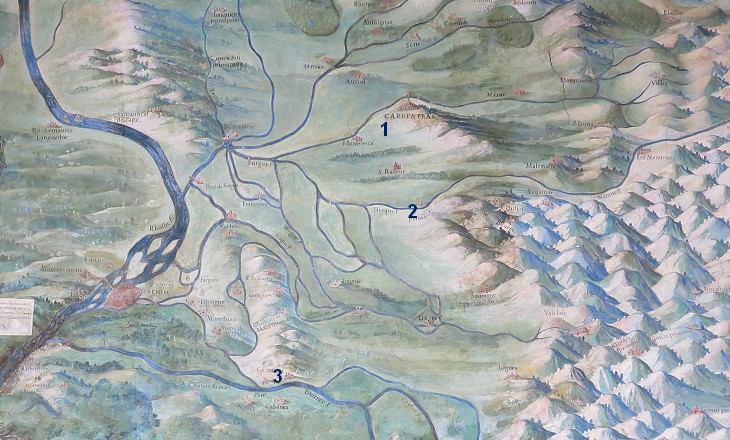
Map of Comtat Venaissin, the region east of Avignon in a 1580 fresco at Galleria delle Mappe Geografiche in the corridors of Palazzo del Belvedere in Rome: 1) Carpentras; 2) Pernes-les-Fontaines; 3) Cavaillon
The county
of Venaissin is so called, as some say, "a venatione" (after hunting),
because it is a sporting country, or as others pretend, from Venasque, formerly an imperial city,
and the chief of the country. It is subject to the Pope and contains: 1. The diocese of Avignon;
chief town Avignon. 2. The diocese of Cavaillon;
chief town Cavaillon. 3.The diocese of Carpentras;
chief towns, Carpentras and Pernes. 4. The diocese
of Vaison; chief town of the same name.
Thomas Nugent - The Grand Tour - 1749
The Popes were bequeathed Comtat Venaissin by Alphonse II, Count of Toulouse in 1271. In his will he left most of his fiefdoms to his nephew King Philip III of France, but Comtat Venaissin, was nominally part of the Holy Roman Empire and the Crown of France had no rights on it. In 1274 Pope Gregory X met with Philip and convinced him to accept the Papal sovereignty on Comtat Venaissin. It was a Papal possession until 1791 when it was annexed to France.
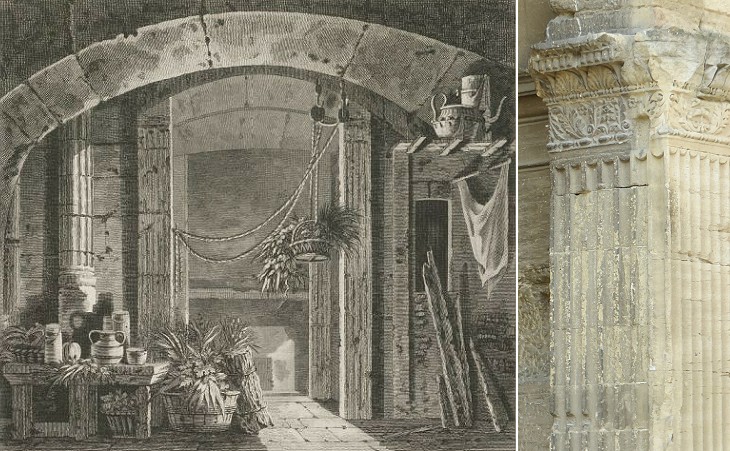
(left) Roman Arch in a plate from "Alexandre de Laborde - The Monuments of France Chronologically Classified - 1816-1836"; (right) detail of the Arch
Carpentras, the second town in the department of Vaucluse is agreeably situated, commands a fine plain planted with olive trees, and is surrounded with walls. (..) The objects of curiosity are a noble aqueduct built after the antique (..), the remains of a triumphal arch in the lodge of the prison, the episcopal palace, the front of the cathedral, the grand hospital of which the façade and principal staircase are very fine and the public library.
William Coxe - Galignani's Traveller's Guide Through France -1819
The Popes did not attach much importance to Comtat Venaissin until 1313 when Pope Clement V placed his residence at Carpentras, after his anointment at Lyon in 1305 and after having spent some years in other towns of France. Pope John XXII, his successor, moved the Papal Court to Avignon in 1316, but Carpentras continued to be the capital of Comtat Venaissin.
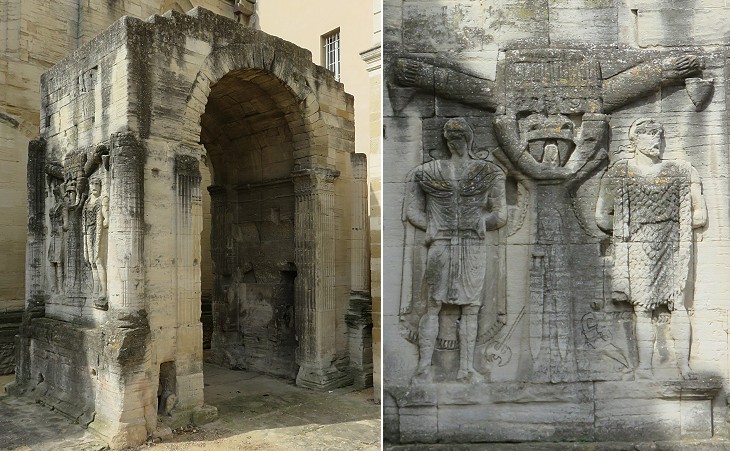
(left) Roman Arch today; (right) side with a relief portraying two captive warriors tied to a trophy
Carpentras was an important Roman station, but almost the only relic of that people remaining is an Arch of Triumph, formerly built up into the bishop's palace, and serving as his kitchen, but recently set free from that degradation, and detached from the buildings surrounding it. It is a ruin reduced to the mere stone vault without the attic resting on the side piers. Upon these are curious sculptures in relief representing Barbarian Captives, their hands bound behind their backs to trophies. Nothing is known of the date or destination of this arch, but it is doubtless a work of the Lower Empire.
John Murray III - Hand-book for Travellers in France - 1843
The two figures were identified as a Parthian (left) and a German (right) captive warrior and this led archaeologists to date the arch at the time of Emperor Tiberius or in the very last years of Emperor Augustus, when the Empire was at war with these two peoples. The arch was therefore erected in the same period as that of nearby Orange, which also has a similar decoration on its short sides.
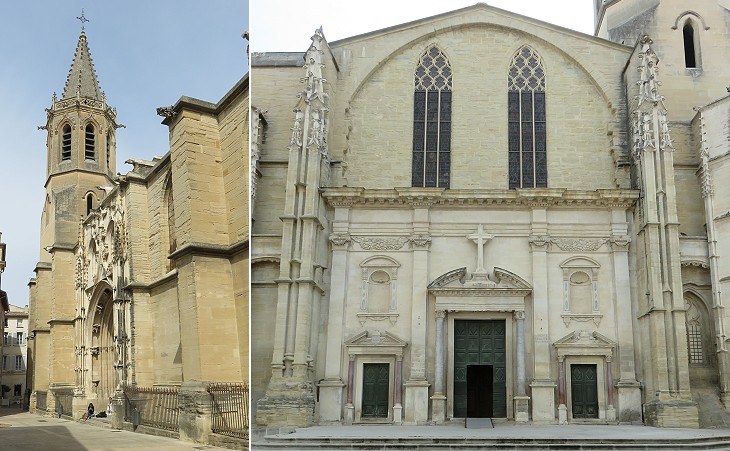
Cathedral: (left) side view; (right) early XVIIth century unfinished façade
The cathedral, rebuilt 1405, has a tower attached to it of the 12th century, and contains a nail of the Cross made into a bit, and used for that purpose by Constantine, if we may believe the tradition. Murray
The arch was moved from its original location, presumably across one of the main streets of Carpentoracte, the Roman town, to the XIIth century Cathedral where it decorated one of the entrances. It ended up by being incorporated into the kitchen of the adjoining Bishop's Palace when the Cathedral was rebuilt.

Cathedral: Gothic features
Carpentras was a bishopric see since the Vth century, but from ca 590 and for many centuries its bishops preferred to reside at Venasque, a small town in a more defensible position than Carpentras. After Comtat Venaissin was acquired by the Popes, the diocese of Carpentras became an important one and it was assigned to close relatives of the Popes when these lived at Avignon. It was merged with that of Avignon in 1801, but it was recreated in 2009.
Petrarch came to settle at Carpentras (..) and he gave himself up to study and learned in five years as much grammar, rhetoric and logic, as can be taught in schools to those of his age. Coxe
Petrarch, a famous Italian poet, lived at Carpentras, where his father worked at the Papal Court, in 1312-1316. During this period he visited for the first time Fontaine-de-Vaucluse, a natural spring surrounded by high rocks which eventually became a source of inspiration for one of his most famous poems.
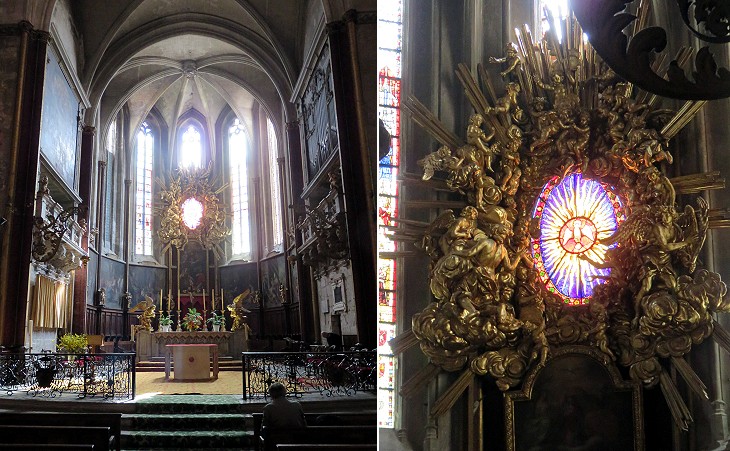
Cathedral: decoration of the apse by Jacques Bernus
In 1692 Bishop Lorenzo Bussi, from a Roman noble family that enlisted three cardinals, commissioned Jacques Bernus with a complex wood decoration for the apse of the Cathedral which clearly was influenced by Roman models and in particular by works by Gian Lorenzo Bernini at S. Pietro. Bernus was the son of a local sculptor; Bishop Bussi praised so much his work that he encouraged him to go to Rome to learn marble sculpture, but he refused to leave Carpentras and he continued to make wood decorations for the churches of the region.
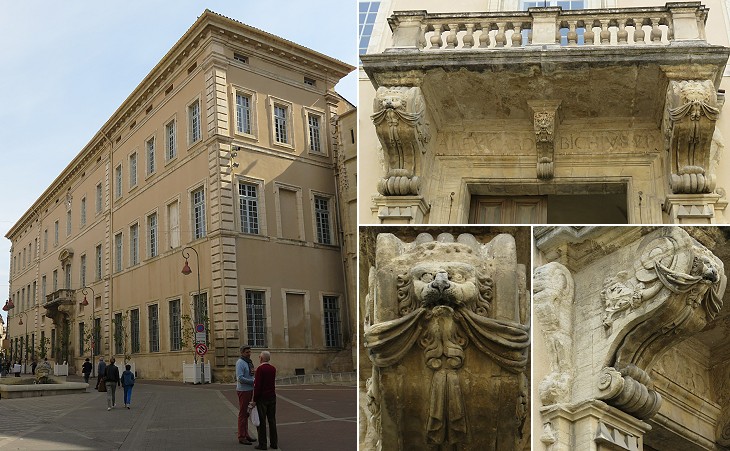
Bishop's Palace and details of its portal
Alessandro Bichi was appointed Bishop of Carpentras in September 1631 and Papal Nuncio (Ambassador) to France a few days later. In 1633 he was made Cardinal by Pope Urban VIII. He established friendly relations with Cardinal Jules Mazarin and he was always a supporter of the French cause at the Papal Court. He was rewarded by France with revenues from abbeys and fiefdoms which allowed him to build a grand Italian-style palace at Carpentras. He was buried at S. Sabina in Rome.
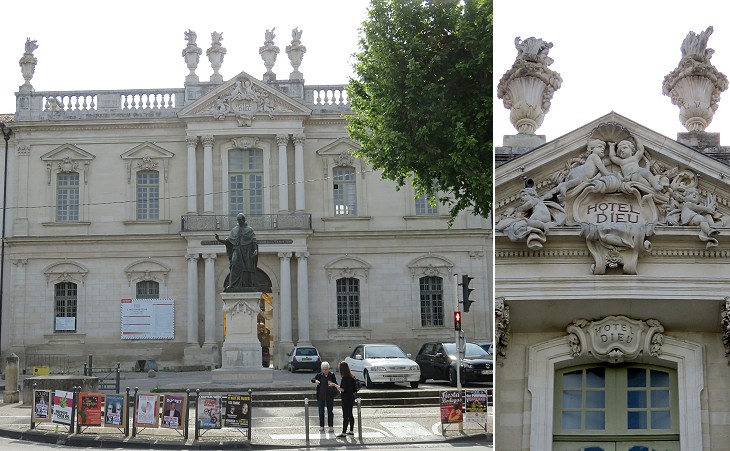
Hotel-Dieu (Hostel of God)
Similar to what occurred at Rome, also at Carpentras institutions were founded to care for the poor and the sick. Joseph-Dominique d'Inguimbert, Bishop of Carpentras in 1735-1757, built a very large hospital with wings arranged around four courtyards. It replaced five previous hospitals which were no longer suitable for their purpose. A statue of the Cardinal was erected in 1858 in front of his hospital, a very unusual sight in France, where, first the French Revolution, and then a very lay legislation on religious matters, have destroyed or greatly limited such monuments.
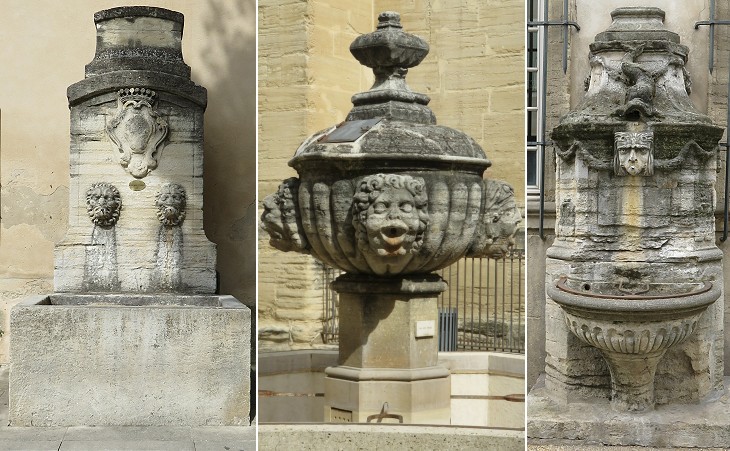
Fountains near: (left) the Bishop's Palace; (centre) the side portal of the Cathedral; (right) the Town Hall
In 1734 a short aqueduct was completed to provide Carpentras with an ample supply of water and a number of public fountains were built to distribute it, but not as many as at Pernes-les-Fontaines.
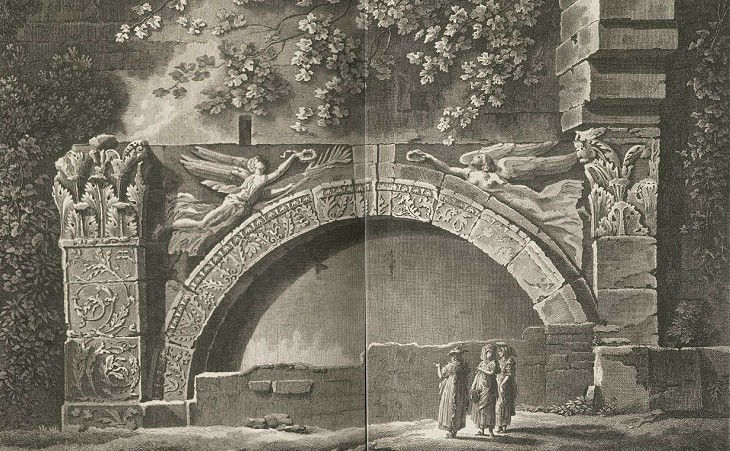
Roman Arch in Laborde's book
Cavaillon is situated on the right bank of the Durance (a major tributary of the River Rhône) and is remarkable for some antiquities, of which the principal is a triumphal arch in the buildings of the bishop's palace. (..) Of Cavaillon Petrarch says it is spoken of as an ancient city, in some authentic memoirs about fifty years before Christ at the time that Julius Caesar conquered Britain. It was formerly built on the mountain and was a Roman colony. Coxe
Higher up the Durance on its rt bank is Cavaillon, where are some mutilated Roman remains, an Arch of Triumph half buried in the ground attributed to the Empress Constantine (?). Murray
The plate by Laborde shows an apparently gigantic fragment of a Roman monument in a garden. It decorated the Bishop's Palace of the town until the building was sold in 1793 and it fell into abandonment becoming itself a ruin. Laborde wrote in his book that other fragments were visible near that of the plate.
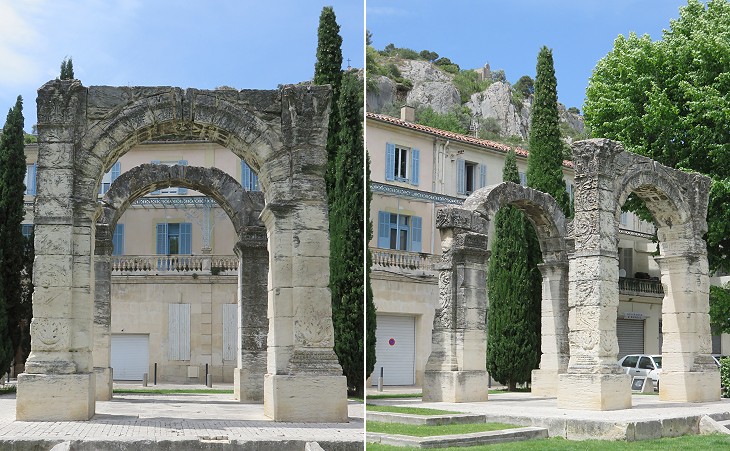
Roman Arch, actually a "tetrapylon" (four stones), today
The fragments were studied and eventually reassembled in order to reconstruct two identical small arches. They were placed in a new location and in a way which suggests that the original monument was a tetrapylon, an arch with four equal sides at the junction of two important streets. The best known example of tetrapylon is that at Palmyra, but, because of its small size, that at Cavaillon might have resembled the Arch of Marcus Aurelius at Oea (Tripoli).
No inscriptions were found which could help in dating the arch, so archaeologists had to study on its decoration to establish when it was built. In this part of Provence there is an imposing arch at Glanum, in addition to that at Orange, but the decoration of the arch of Cavaillon does not seem to have been influenced by them, a fact which suggests it was built before them, perhaps shortly after the completion in 9 BC of Ara Pacis Augustae, the altar dedicated to Augustus by the Roman Senate. This opinion is supported by the similarities between the acanthus scrolls of the two monuments.
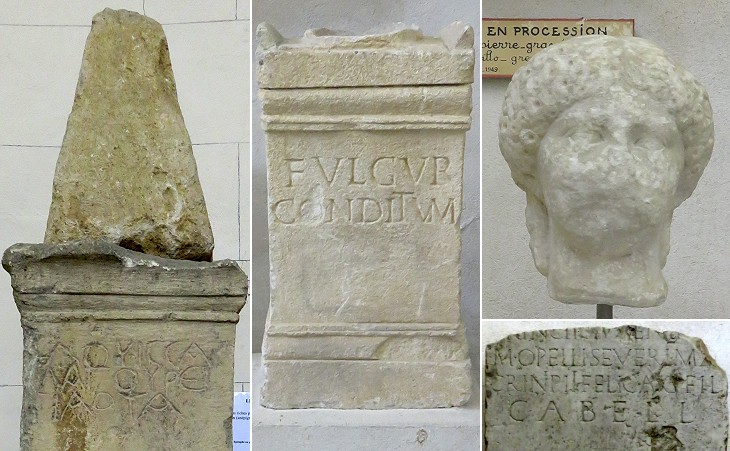
Lapidary Museum: (left) Celtic stela written in Greek alphabet (IInd century BC); (centre) altar with inscription meaning "struck by lightning" similar to another one found at Ostia; (right-above) head of Agrippina; (right-below) inscription celebrating Emperor Macrinus with the name of the town: "CABELL(io)
In 1938 a small archaeological museum was opened in a deconsecrated chapel, similar to what occurred at Vienne and Avignon. It contains exhibits which testify to the long history of the town, including the influence of the Greek colony of Marseille on the local population before the Roman conquest. In the introductory page to this section you can see a relief depicting a boat carrying wine and olive oil on the River Durance, which was found near Cavaillon.
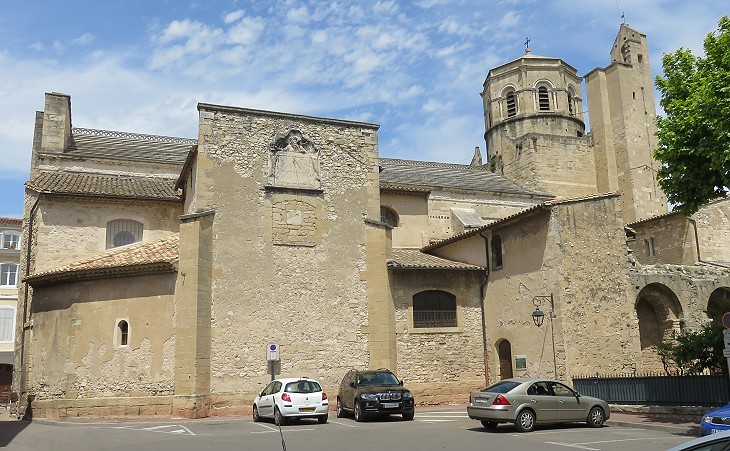
Former Cathedral (the diocese of Cavaillon was abolished in 1801)
Cavaillon has a curious Romanesque Cathedral; St Veran of the 13th century with an apse of the 12th. Attached to it is a curious Cloister. Murray
The Cathedral was dedicated to Saint Veranus of Cavaillon who in the VIth century lived as a hermit at Vaucluse before being appointed Bishop of Cavaillon.
The town was less important than Carpentras, but its economy could rely on a very fertile countryside.
Another delightful excursion may be made to Cavaillon, a small town about twelve miles distant from Avignon. Here the traveller will conceive himself transported into the most beautiful garden, justly entitled to the appellation of the Eden of Provence. Finer vegetables, more lovely clusters of trees, richer vineyards and olive hills are nowhere to be found. Artichokes, peaches and winter melons sent as far as Paris are the most in request from Cavaillon and the inhabitants have the reputation of being the best gardeners in Provence. Coxe
In 1864 Alexandre Dumas received a request from the librarian of Cavaillon, who asked him for a few volumes of his works. He answered "If the city and the authorities of Cavaillon value my books, I love their melons very much and I desire that in exchange for my 300 volumes, a life annuity of twelve melons per year be constituted for me". The City Council accepted this offer and delivered his twelve annual melons to Alexandre Dumas until his death in 1870.
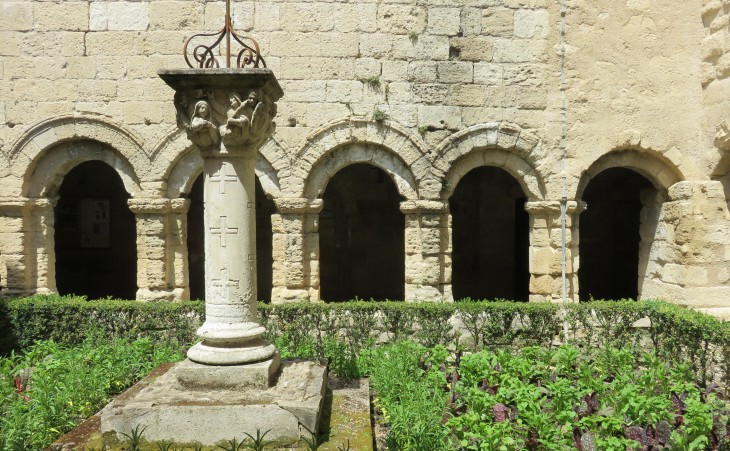
Former Cathedral: cloister (1175-1125)
The Cathedral was sacked and partially burnt during the "First" French War of Religion (1562-1563). It was restored in the following century, but these events did not impact on the small cloister.
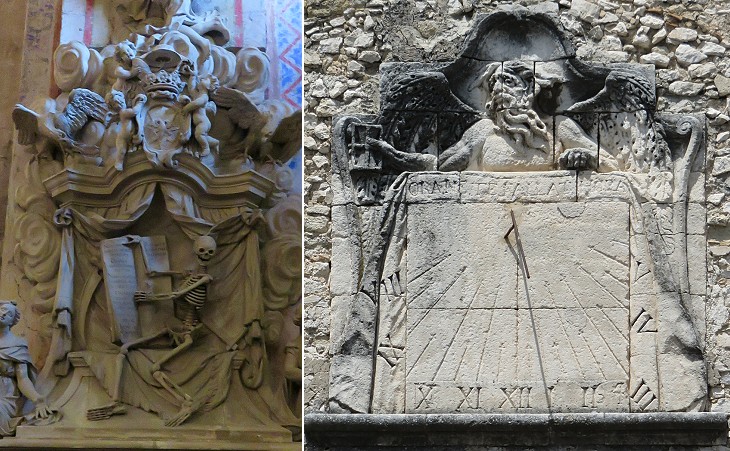
Former Cathedral: (left) 1710 monument to Jean-Baptiste de Sade de Mazan by Jean André Maucord; (right) sundial with inscription "Ora ne te fallat hora" "Pray that the hour take thee not unawares"
Memento Mori is a page of this website which covers Baroque funerary monuments and decorative elements which reminded the Romans of their death. They were in fashion in the XVIIth and XVIIIth centuries also at Cavaillon.
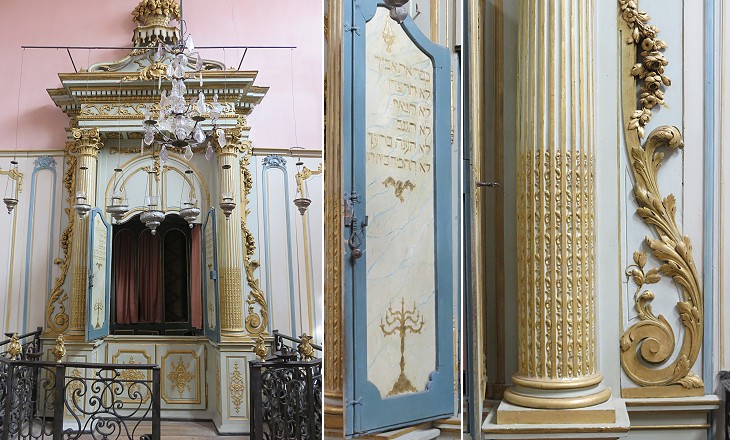
Former Synagogue: Torah Ark and details of its decoration
There are abundance of Jewes inhabiting in this Citty (Avignon),
and to distinguish them from other People they ware yellow
hatts. They are most of them very poore and much slighted
by the Inhabitants. They have here their Synagogue and
observe the Ceremonyes of the old Testament.
Francis Mortoft's Journal of his travels in France and Italy in 1659
The Kings of France decreed the expulsion of the Jews more than once; in particular in 1394 (Expulsion Finale) and in the early XVIth century from their new territories in Provence. Avignon and Comtat Venaissin were the only parts of Southern France where they were allowed to live, although they were subject to restrictions and vexations similar to those enforced in Rome by Pope Paul IV. Their living conditions depended very much on the benevolence of Bishops and Papal Legates; their synagogues and religious schools were not allowed to have a proper street façade. In 1772-1774 the small Jewish community of Cavaillon managed to redecorate the Synagogue in the fashion of the time. The synagogue was closed in the XIXth century because the Jews left the town. Luckily in 1924 it was listed among the historical monuments of France and in 1963 it was turned into a small museum.
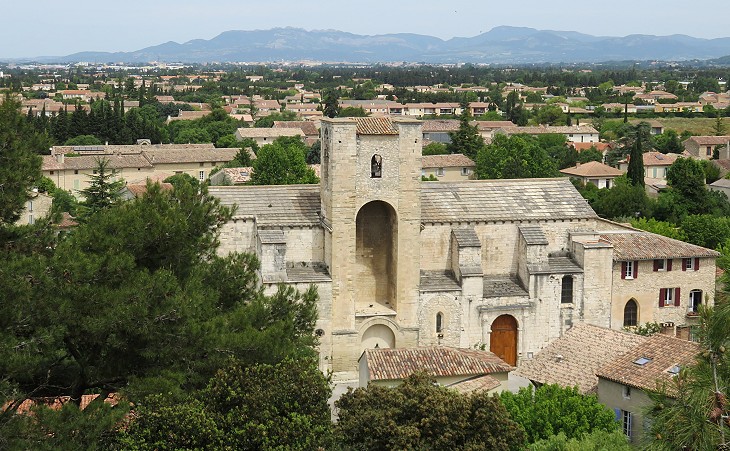
Notre-Dame-de-Nazareth and in the distance Carpentras from the top of a medieval tower
This small town was the capital of Comtat Venaissin when it belonged to the Counts of Toulouse, but it was soon replaced by Carpentras. In 1936 the suffix les-Fontaines was added to underline its main touristic attraction. It is crossed by the River Nesque which empties into a branch of the River Sorgue.
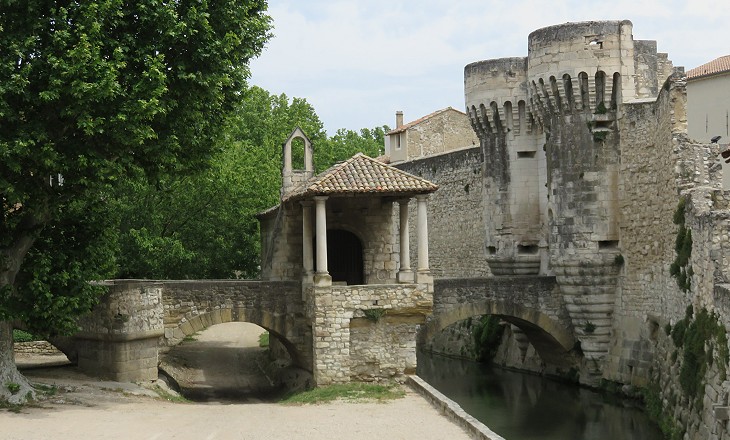
Porte Notre-Dame and the tiny chapel of Notre-Dame-des-Graces
The section of the town on the left bank of the Nesque was protected by walls which were strengthened in 1548 by the construction of a new imposing gate at the end of a bridge on the Nesque. It is named after Notre-Dame-de-Nazareth, the most important church of Pernes, which stands on the other side of the river on the road leading to Carpentras.
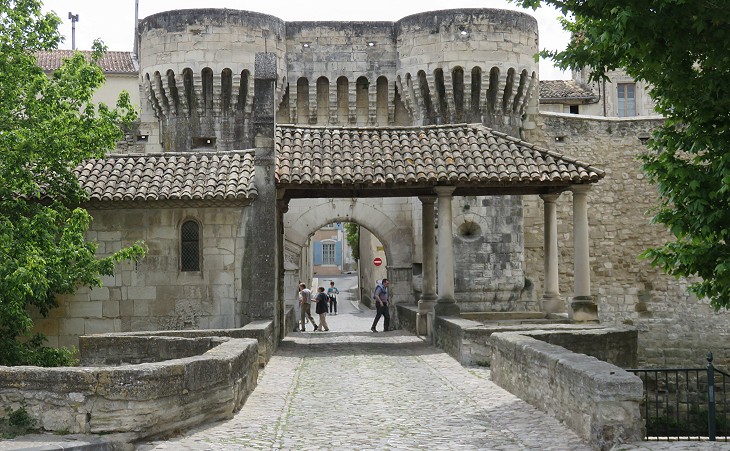
Another view of Porte Notre-Dame and of Notre-Dame-des-Graces
In 1915 the gate, the bridge and the chapel of a local guild were declared historical monuments, a decision which ensured they were not sacrificed to the needs of modern life. They make a very evocative view and per se justify a visit to the town. Also Pont Saint-Bénézet at Avignon had a chapel on it.
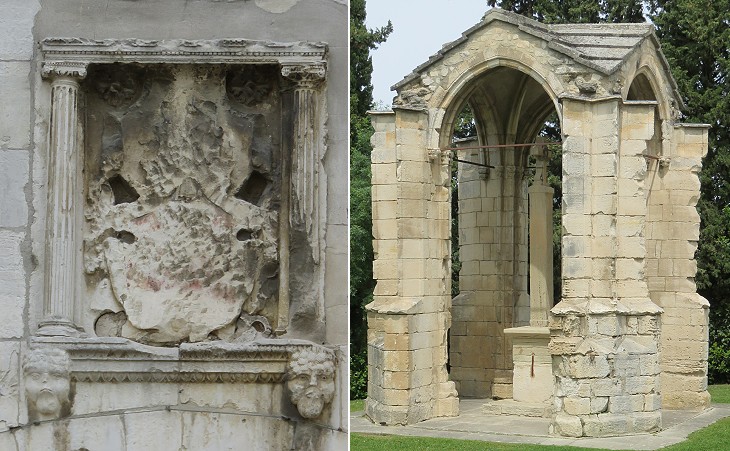
(left) Erased papal coat of arms at Porte Notre-Dame; (right) Croix Couverte
The French Revolution had an impact also at Pernes where all references to the Popes were erased (see a page on what occurred in some Papal towns in Italy). In addition a column with a cross was replaced by a pike with a Phrygian red cap, a symbol of the Revolution. It stood in a sort of small tetrapylon which was erected in 1433 to celebrate the visit of Cardinal Pierre de Foix who restored the authority of Pope Eugenius IV over Comtat Venaissin after the Great Schism.

Notre-Dame-de-Nazareth: southern portal
This church was built in the XIth century as part of an abbey. Similar to the Cathedral of Cavaillon it was damaged in 1562, but its southern portal retains its original design and decoration which definitely resemble those of a Roman building (the lintel perhaps is an ancient one).
The Romanesque of Provence has all the delicacy of
an advanced art bestowed on the simple and strenuous
forms of a round-arched style.
Thomas Graham Jackson - Byzantine and Romanesque Architecture - 1913
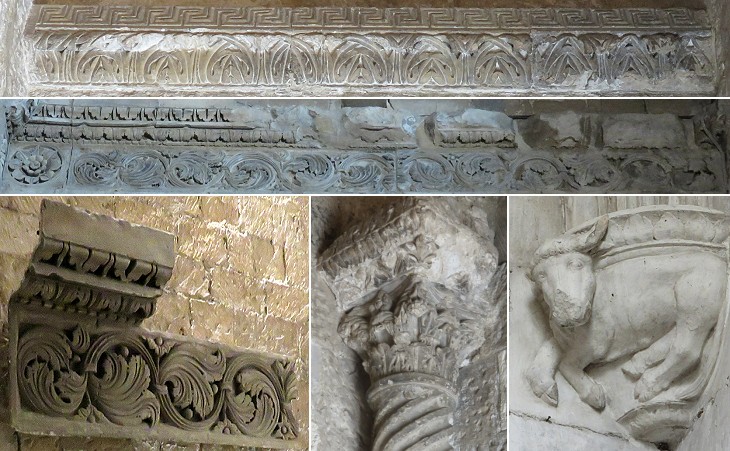
Notre-Dame-de-Nazareth: details of the interior; the image used as background for this page shows a capital which is very similar to one at Notre-Dame-du-Lac, another fine Romanesque church at nearby Le Thor
The interior retains some other elements of the original church, which show how much Romanesque art is indebted to the Roman one (you may wish to see also Saint-Quenin at Vaison-la-Romaine). In most part of Europe Romanesque art was inspired by models which were first developed in Lombardy (see an example in Rome), but in Provence it was directly influenced by the ancient monuments of the region.
Provence has a history of its own
distinct from the rest, for it had not even that feudal
relation to the French crown, which the semi-independent Kingdom
provinces, such as Aquitaine and Normandy, acknowledged. It is therefore not surprising that the early architecture
of post-Roman times in Provence should differ a good
deal from that of the rest of France, and constitute a
school of its own. It is inspired by that of Imperial Rome; and this was
natural in a country even now so rich in Roman remains,
and probably much richer still from the days of the
Empire down to the Middle Ages. Jackson

Fountains: (left to right) Saint-Augustin; du Gigot; de l'Hopital
The oldest records about the fountains of Pernes are dated XVth century, but most of the fine public fountains which embellish this small town were built after a new spring of pure water was found by chance in its outskirts in 1750.
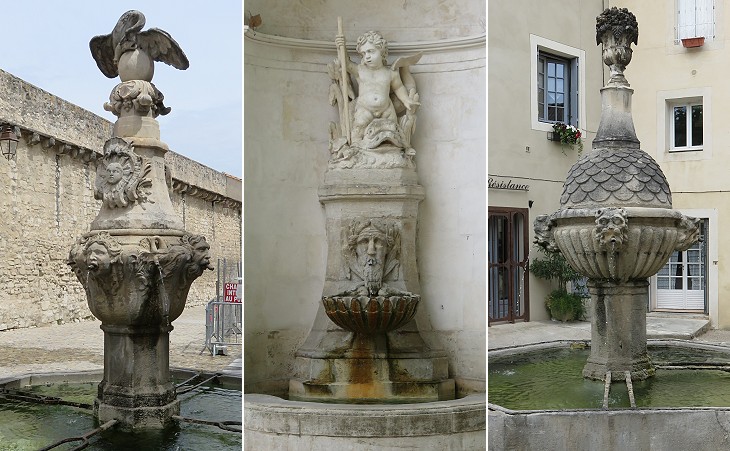
Fountains: (left to right) du Cormoran; de l'Hotel de Ville; Reboul
Plan of this section:
Introductory page
Arles (Arelate)
Environs of Arles: Saint-Gilles, Aigues-Mortes and Saintes-Maries-de-la-Mer
Avignon (Avenio)
Carpentras (Carpentaracte), Cavaillon (Cabellio) and Pernes-les-Fontaines
Fontaine-de-Vaucluse and Le Thor
Glanum
Lyon (Lugdunum)
Marseille (Massilia)
Narbonne (Narbo Martius)
Nîmes (Nemausus)
Orange (Arausio)
Pont-du-Gard and Uzès
Saint-Bertrand-des-Comminges (Lugdunum Convenarum)
Tarascon (Tarasco)
Toulouse (Tolosa)
Vaison-la-Romaine (Vasio)
Vienne (Vienna)
Villeneuve-lez-Avignon

